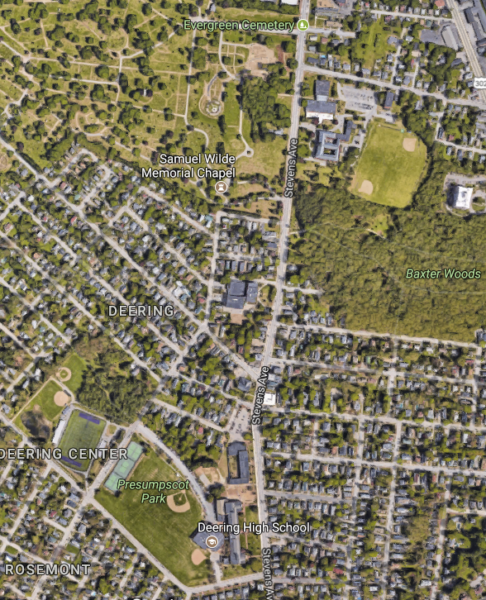By Susan Ransom
 Last night I walked over to our community garden plot with my husband and our dog, greeting neighbors (and their dogs) along the way. Within five blocks I can walk to the library, the Quality Shop, Pat’s Meat Market, Baxter Woods, Siano’s restaurant, Roy’s Shoe Repair, the Sewing Shop, Jet Video, and ten other neighborhood amenities. My neighbors walk their kids to school past my house, and from my kitchen I hear games going on in the Deering High School playfields: soccer camp, band practice, lots of cheering.
Last night I walked over to our community garden plot with my husband and our dog, greeting neighbors (and their dogs) along the way. Within five blocks I can walk to the library, the Quality Shop, Pat’s Meat Market, Baxter Woods, Siano’s restaurant, Roy’s Shoe Repair, the Sewing Shop, Jet Video, and ten other neighborhood amenities. My neighbors walk their kids to school past my house, and from my kitchen I hear games going on in the Deering High School playfields: soccer camp, band practice, lots of cheering.
I live very close to legendary Stevens Avenue in Portland, Maine, the only street in America, we are fond of saying, where you can be born, go to kindergarten through graduate school, work, get married, die, and be buried, all without leaving the street. I think the “born” part refers to the proximity of the old Brighton Medical Center, which no longer does births and isn’t strictly on Stevens anyway, but otherwise it’s true. Stevens Avenue is home to numerous public and private schools, the University of New England, Maine’s only dental school, churches, Maine’s (probably) only Polish restaurant, Aubuchon hardware, coffee shops, and a tattoo parlor. And we all hope to end up under the elegant turf of Evergreen Cemetery.

Courtesy of Friends of Evergreen, friendsofevergreen.org
Until recently, though, my neighborhood, Deering Center, had an unfortunate gap in independent housing for older adults. The houses are modest and vertical. If you can’t do stairs, and you aren’t ready to move into Deering Pavilion, you can’t live in this walking paradise. As my neighbors and I age and retire, a walkable neighborhood promotes not only healthy exercise but the added pleasure of maintaining social bonds. Moving to find simplified one-floor living, cutting the casual ties of neighborhood life, is not only painful, it’s disorienting and isolating.
Reserve your seat at our Bangor half-day forum ‘The Case for Walkability: Health, Economic Development, and Sustainability’ on September 19th. Click here for more information.
Fortunately, construction has begun on the former Sisters of Mercy Mother House, a conversion of the convent into senior housing with the potential for three new buildings of more senior housing to be built behind it. And a smaller apartment building is under construction right next to Roy’s Shoe Repair. As my friends and I get our joints replaced and have a harder time carrying the laundry up two flights, we can look forward to appropriate, convenient housing that makes the legend of Stevens Avenue closer to true. We’ll still be able to live our lives—cradle to grave—and walk to everything.
Susan Ransom
Marketing Director, PDT Architects
GrowSmart Maine volunteer, Deering Center resident

